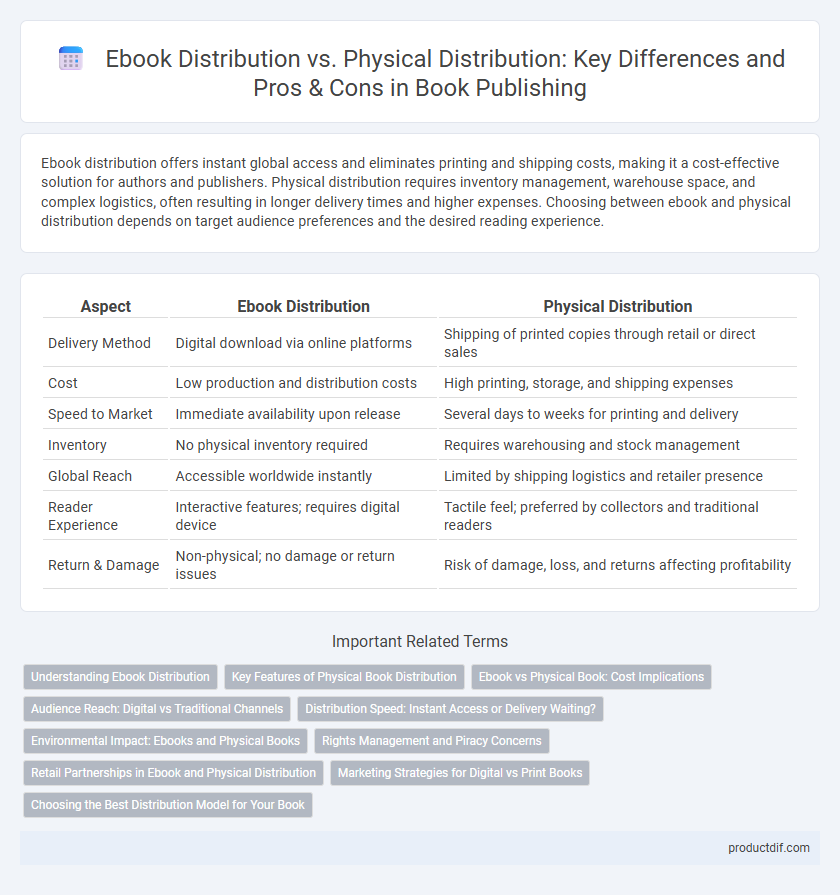Ebook distribution offers instant global access and eliminates printing and shipping costs, making it a cost-effective solution for authors and publishers. Physical distribution requires inventory management, warehouse space, and complex logistics, often resulting in longer delivery times and higher expenses. Choosing between ebook and physical distribution depends on target audience preferences and the desired reading experience.
Table of Comparison
| Aspect | Ebook Distribution | Physical Distribution |
|---|---|---|
| Delivery Method | Digital download via online platforms | Shipping of printed copies through retail or direct sales |
| Cost | Low production and distribution costs | High printing, storage, and shipping expenses |
| Speed to Market | Immediate availability upon release | Several days to weeks for printing and delivery |
| Inventory | No physical inventory required | Requires warehousing and stock management |
| Global Reach | Accessible worldwide instantly | Limited by shipping logistics and retailer presence |
| Reader Experience | Interactive features; requires digital device | Tactile feel; preferred by collectors and traditional readers |
| Return & Damage | Non-physical; no damage or return issues | Risk of damage, loss, and returns affecting profitability |
Understanding Ebook Distribution
Ebook distribution leverages digital platforms and online retailers to deliver instant access to readers worldwide without the need for physical storage or shipping, significantly reducing costs and geographic limitations. It enables dynamic pricing, real-time sales tracking, and easier updates or revisions compared to traditional physical book distribution through bookstores and distributors. Understanding ebook distribution involves mastering digital rights management, metadata optimization, and selecting appropriate sales channels like Amazon Kindle, Apple Books, and Google Play Books to maximize visibility and revenue.
Key Features of Physical Book Distribution
Physical book distribution involves tangible inventory management, requiring warehousing and transportation logistics to ensure timely delivery to bookstores and libraries. This method supports in-person browsing and immediate purchase, enhancing customer experience through physical presence and tactile engagement. It also allows for traditional shelf placement and visual merchandising, which can drive impulse buys and brand visibility in retail environments.
Ebook vs Physical Book: Cost Implications
Ebook distribution eliminates printing, storage, and shipping costs, making it significantly more cost-effective than physical book distribution. Authors and publishers save on inventory management and can reach a global audience instantly with minimal overhead. Physical books require upfront investment in printing, warehousing, and logistics, which increases overall expenses and retail prices.
Audience Reach: Digital vs Traditional Channels
Ebook distribution leverages digital platforms and global online marketplaces, enabling authors to reach a broader audience instantly without geographical limitations. Physical distribution relies on traditional bookstores and libraries, often restricting reach to local or regional markets but providing tactile experiences valued by certain readers. The scalability of digital channels outpaces physical methods, making ebooks more accessible to a diverse and international readership.
Distribution Speed: Instant Access or Delivery Waiting?
Ebook distribution offers instantaneous access to content through digital platforms, eliminating the wait times associated with shipping and handling inherent in physical book distribution. Physical distribution requires inventory management, packaging, and transit, resulting in variable delivery times ranging from days to weeks. Rapid availability of ebooks enhances reader engagement and convenience, while physical copies provide tangible value but with delayed accessibility.
Environmental Impact: Ebooks and Physical Books
Ebook distribution significantly reduces environmental impact by eliminating the need for paper, ink, and transportation emissions associated with physical book production and delivery. Physical books require substantial resources, including trees for paper, chemical processes for ink, and fuel for shipping, contributing to deforestation and greenhouse gas emissions. The sustainability benefits of ebooks include reduced carbon footprints and less waste, making digital formats a greener choice for environmentally conscious readers.
Rights Management and Piracy Concerns
Ebook distribution offers enhanced rights management through digital rights management (DRM) technologies that restrict unauthorized copying and sharing, significantly reducing piracy risks compared to physical distribution. Physical books, while less vulnerable to digital piracy, face challenges with lost or stolen copies that cannot be easily tracked or controlled. Publishers leveraging ebook distribution benefit from real-time monitoring and adjustable access permissions, providing stronger protection of intellectual property rights.
Retail Partnerships in Ebook and Physical Distribution
Retail partnerships in ebook distribution leverage digital platforms like Amazon Kindle and Apple Books to provide instant global access and seamless purchasing experiences, optimizing discoverability through algorithmic recommendations. Physical distribution relies on established bookstore chains and independent retailers, emphasizing shelf placement, in-store promotions, and personal customer interactions to drive sales and brand loyalty. Both channels benefit from strategic alliances, but ebooks excel in scalable reach and cost-efficiency, while physical books capitalize on tactile appeal and local market presence.
Marketing Strategies for Digital vs Print Books
Ebook distribution leverages digital marketing strategies such as targeted social media ads, email campaigns, and search engine optimization to reach a global audience quickly and cost-effectively. Physical book distribution relies on traditional marketing methods including bookstore placements, book tours, and in-store promotions to engage local readers and build brand presence. Digital marketing analytics provide real-time insights for ebook campaigns, enabling precise adjustments, whereas print marketing depends more on sales data and customer feedback gathered over longer periods.
Choosing the Best Distribution Model for Your Book
Ebook distribution offers global reach with instant delivery and lower costs, ideal for authors seeking wide accessibility and faster royalties. Physical distribution provides tangible presence in bookstores and libraries, enhancing credibility and catering to readers who prefer traditional formats. Evaluating your target audience, budget, and marketing goals will determine whether ebook or physical distribution best maximizes your book's success.
Ebook Distribution vs Physical Distribution Infographic

 productdif.com
productdif.com